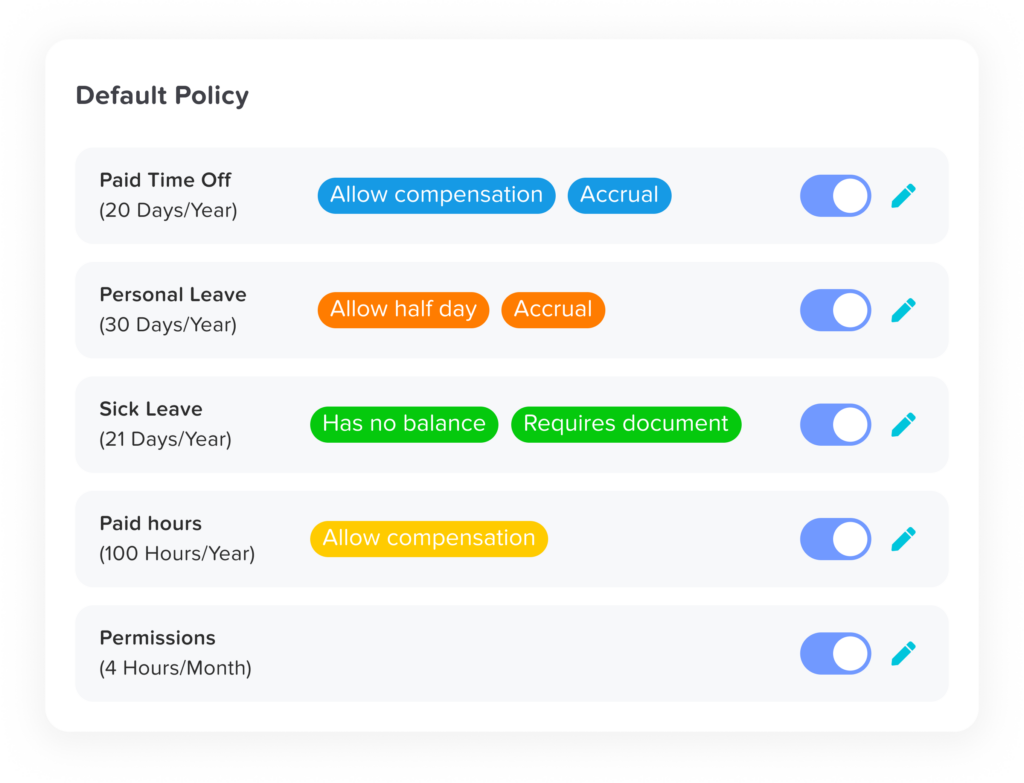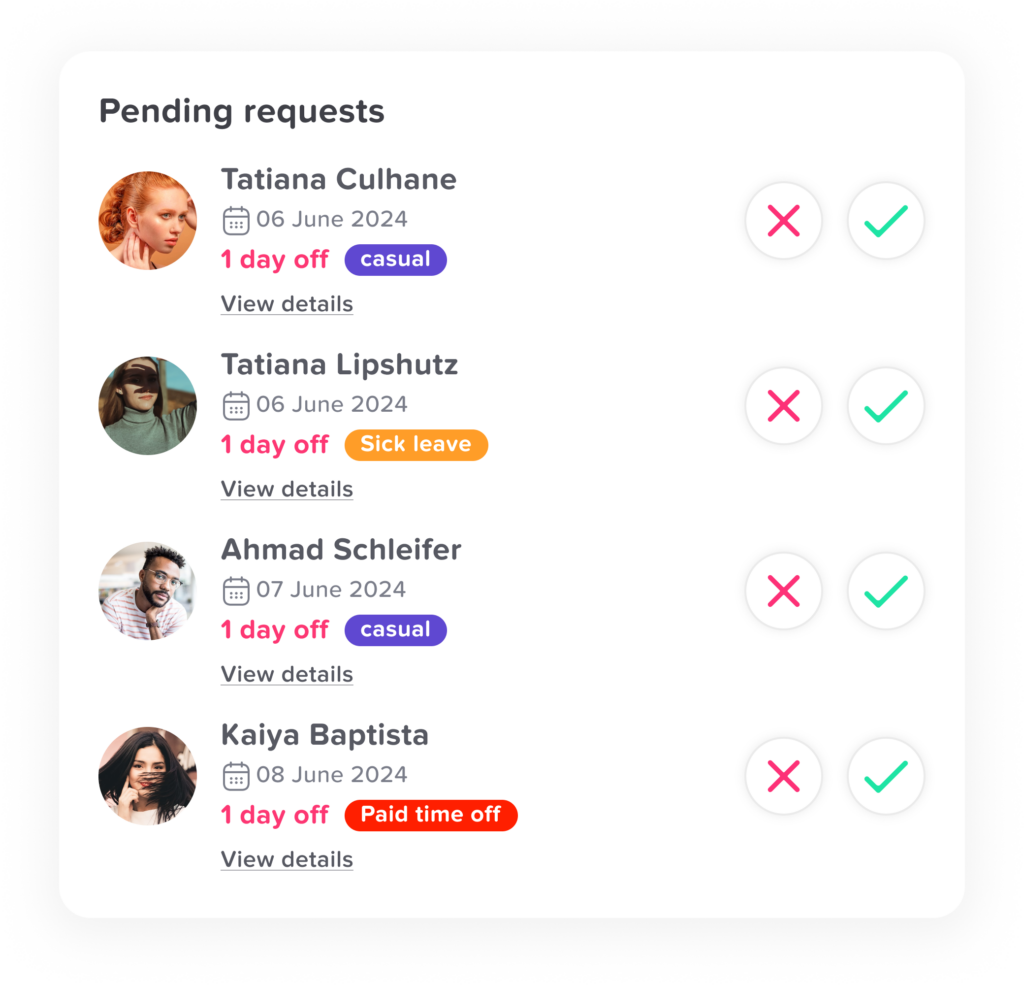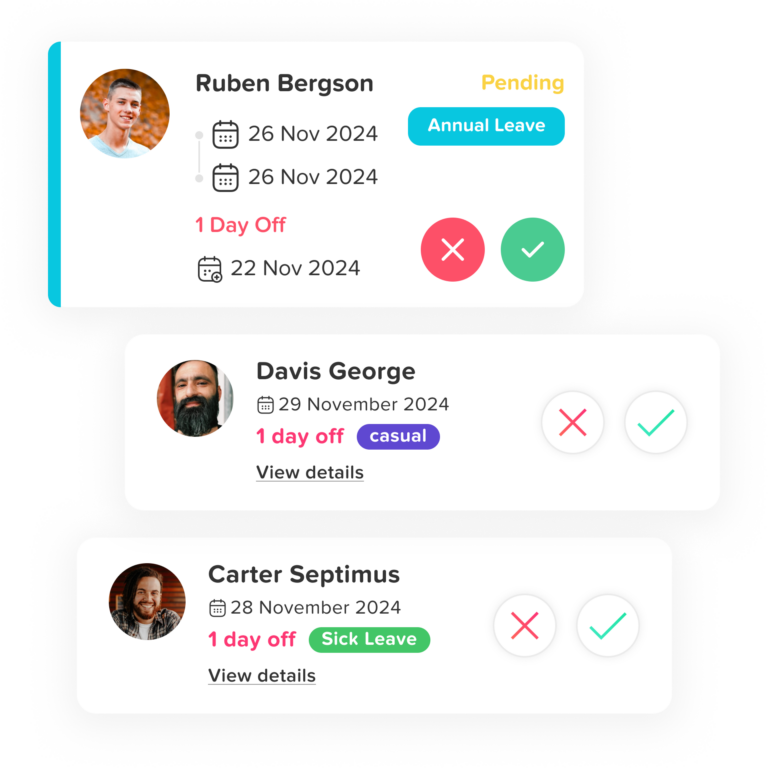Table of Contents
ToggleIn the modern workplace, understanding the various types of leave available is essential for both employers and employees. Leave policies not only ensure that employees have the necessary time to rest and recharge, but they also support work-life balance, promote employee well-being, and help companies maintain a productive workforce. Below is an overview of the most common types of leave, their purposes, and how they are typically managed within organizations.
Annual Leave
Annual leave, also known as vacation leave, is the most common type of leave. It allows employees to take paid time off for personal reasons, vacations, or simply to rest. The amount of annual leave varies by country and company, but it typically accumulates over time based on the length of service. For instance, an employee might earn a certain number of days per month or year, which can be taken in full or in part at the employee’s discretion.
Key Points:
- Purpose: Rest, relaxation, personal time.
- Paid: Yes.
- Accumulation: Often based on tenure or company policy.
- Notice: Typically requires prior approval from the employer.

Sick Leave
Sick leave is provided to employees when they are unable to work due to illness or injury. This type of leave ensures that employees can recover without the pressure of losing income. Sick leave policies vary widely; some companies offer a fixed number of sick days per year, while others provide leave on an as-needed basis.
Key Points:
- Purpose: Recovery from illness or injury.
- Paid: Often, but not always. Some countries mandate paid sick leave.
- Duration: Varies, sometimes requiring a doctor’s note for extended periods.
- Notice: Typically, employees are required to notify their employer as soon as possible.
Maternity and Paternity Leave
Maternity leave is specifically for mothers before and after childbirth, allowing them time to recover and bond with their newborns. Paternity leave is granted to fathers, though typically for a shorter duration, to support their partners and spend time with the new baby. In some regions, parental leave may be available for either parent to take after the birth or adoption of a child.
Key Points:
- Purpose: Childbirth recovery, bonding with the child.
- Paid: Varies by country; some offer paid leave, others unpaid.
- Duration: Maternity leave typically lasts longer than paternity leave, with parental leave offering flexible options.
- Notice: Often requires prior planning and notice to the employer.
Parental Leave
Beyond maternity and paternity leave, parental leave allows either parent to take time off to care for a child, including adoption cases. This type of leave is more flexible and can often be shared between both parents.
Key Points:
- Purpose: Childcare, bonding, adoption-related leave.
- Paid: Depends on the country and employer.
- Duration: Flexible; can be months to even a year, sometimes split between parents.
- Notice: Requires planning and often needs to be coordinated with the employer.
Bereavement Leave
Bereavement leave, also known as compassionate leave, is granted to employees who need time off due to the death of a family member or loved one. This leave allows employees to grieve, attend funerals, and manage any related affairs.
Key Points:
- Purpose: Grieving, funeral attendance, managing affairs.
- Paid: Often, but not always.
- Duration: Short-term, usually ranging from a few days to a week.
- Notice: Typically provided as soon as the situation arises.
Personal Leave
Personal leave is a broader category that allows employees to take time off for reasons not covered by other types of leave. This could include attending to family matters, handling personal business, or simply taking a mental health day. Personal leave may be paid or unpaid, depending on company policy.
Key Points:
- Purpose: Personal matters, mental health, family emergencies.
- Paid: Varies by employer.
- Duration: Varies; may be a few days or longer.
- Notice: Usually requires prior notice and approval from the employer.
Unpaid Leave
Unpaid leave is granted when an employee needs time off but does not have any paid leave available or if the situation does not qualify for other types of leave. While the employee retains their job, they do not receive salary or wages during this period. Unpaid leave is often used for extended personal matters, long-term medical care, or other significant life events.
Key Points:
- Purpose: Extended personal needs, special circumstances.
- Paid: No.
- Duration: Flexible, as agreed upon with the employer.
- Notice: Requires prior agreement with the employer.
Study Leave
Study leave is offered to employees who are pursuing further education or professional development. This type of leave is usually pre-approved and may be paid or unpaid, depending on the relevance of the course or program to the employee’s job.
Key Points:
- Purpose: Education, professional development.
- Paid: Sometimes, especially if the course benefits the company.
- Duration: Varies depending on the length of the course or program.
- Notice: Typically requires approval and alignment with company policy.


Sabbatical Leave
Sabbatical leave is a more extended period of leave, often granted after several years of service, allowing employees to take time off for personal growth, research, travel, or other significant life projects. It is typically unpaid but may be paid in some academic or research settings.
Key Points:
- Purpose: Personal growth, research, significant life projects.
- Paid: Rarely, unless in academic roles.
- Duration: Can range from a few months to a year.
- Notice: Requires long-term planning and approval.
Emergency Leave
Emergency leave is granted to employees who need to respond to urgent, unexpected situations, such as a family emergency, natural disaster, or other critical incidents. This type of leave is generally short-term and may be paid or unpaid, depending on the company’s policies and the nature of the emergency.
Key Points:
- Purpose: Responding to urgent, unforeseen situations.
- Paid: Varies by employer and situation.
- Duration: Typically short-term, but flexible based on need.
- Notice: Employees should inform their employer as soon as possible.
Jury Duty Leave
Jury duty leave is provided to employees who are summoned to serve on a jury. This leave is typically mandated by law, ensuring that employees can fulfill their civic duties without fear of losing their job. Some companies offer paid jury duty leave, while others may provide unpaid leave.
Key Points:
- Purpose: Fulfilling civic duties as a juror.
- Paid: Often, but not always; varies by jurisdiction.
- Duration: Depends on the length of the trial.
- Notice: Employees should notify their employer as soon as they receive the summons.
Military Leave
Military leave is granted to employees who are members of the armed forces and are called to active duty or required to attend military training. This leave is often protected by law, ensuring that employees can serve their country without risking their employment. Military leave may be paid or unpaid, depending on the employer and jurisdiction.
Key Points:
- Purpose: Active duty, military training, service obligations.
- Paid: Varies by employer; some offer paid leave, while others do not.
- Duration: Depends on the length of service or training.
- Notice: Employees should provide as much notice as possible.
Religious Leave
Religious leave allows employees to take time off for religious observances, ceremonies, or holidays that are not otherwise recognized as public holidays. This type of leave is important for supporting religious diversity within the workplace. It can be paid or unpaid, depending on company policy and the specific religious observance.
Key Points:
- Purpose: Observing religious holidays, ceremonies, or practices.
- Paid: Varies by employer.
- Duration: Flexible, depending on the observance.
- Notice: Employees should request religious leave in advance to allow for scheduling adjustments.
Voting Leave
In some regions, employers are required to provide employees with time off to vote in local, state, or national elections. Voting leave ensures that employees can participate in the electoral process without conflict with their work schedule. The specifics of this leave, including whether it is paid, vary by jurisdiction.
Key Points:
- Purpose: Allowing employees to vote in elections.
- Paid: Depends on local laws and company policy.
- Duration: Usually limited to the time needed to vote.
- Notice: Employees should inform their employer of their voting plans in advance.
Family and Medical Leave (FMLA)
In countries like the United States, the Family and Medical Leave Act (FMLA) allows employees to take extended time off for serious health conditions affecting themselves or their immediate family members, or for situations like the birth or adoption of a child. While FMLA leave is unpaid, it offers job protection during the leave period.
Key Points:
- Purpose: Serious health conditions, family care, childbirth, adoption.
- Paid: No, but job protection is provided.
- Duration: Up to 12 weeks in a 12-month period.
- Notice: Requires prior notice and medical certification in most cases.
Compensatory Leave (Comp Time)
Compensatory leave, often referred to as “comp time,” is provided to employees who work overtime or on public holidays. Instead of receiving overtime pay, employees are given additional time off, equivalent to the extra hours worked. This type of leave is common in sectors where employees may be required to work irregular hours.
Key Points:
- Purpose: Compensation for overtime or holiday work.
- Paid: No, the compensation is in the form of time off.
- Duration: Equivalent to the overtime hours worked.
- Notice: Typically requires scheduling in advance with the employer.
FAQ: Additional Questions on Leave Policies
Can an employee combine different types of leave, such as sick leave and annual leave?
Yes, employees can often combine different types of leave, but this depends on company policy and local laws. For example, an employee might use sick leave first and then take annual leave if additional time off is needed for recovery. However, it is essential to get approval from the employer to combine leave types.
What happens if an employee doesn’t use all their annual leave by the end of the year?
The treatment of unused annual leave varies by company policy and local regulations. Some employers allow employees to carry over unused leave to the next year, while others may have a “use it or lose it” policy. In some cases, employers may pay out the unused leave.
Is there a maximum limit on how much leave an employee can accumulate?
Many companies set a cap on how much leave can be accumulated to encourage employees to take time off regularly. Once the cap is reached, employees may stop accruing additional leave until they use some of their existing balance. This cap varies widely between organizations.
Can an employer deny a leave request?
Employers can deny leave requests if they conflict with business needs, but this depends on the type of leave and local laws. For example, annual leave may be denied if it coincides with a critical work period, but leave mandated by law, such as FMLA or jury duty leave, generally cannot be denied.
What should an employee do if they need to leave for a reason not covered by company policies?
If an employee needs leave for a reason not covered by existing policies, they should discuss the situation with their HR department or supervisor. In some cases, the company may grant unpaid leave or make special arrangements depending on the circumstances.
How does leave work for part-time employees or those on probation?
Leave policies for part-time employees often differ from those for full-time staff, with leave being prorated based on the number of hours worked. Employees on probation may have restricted leave options until they complete their probationary period, though this varies by company policy.
What documentation is typically required when applying for leave?
The documentation required depends on the type of leave. For example, sick leave might require a doctor’s note for extended absences, while parental leave may need proof of childbirth or adoption. Employers usually specify the necessary documentation in their leave policies.
Can an employee be contacted by their employer while on leave?
While on leave, especially for health or personal reasons, employees generally have the right to disconnect. However, in some cases, especially during annual or unpaid leave, employers may need to contact employees for urgent matters. It’s advisable to clarify expectations with your employer before taking leave.
How does leave affect an employee’s benefits, such as health insurance?
The impact of leave on benefits depends on the type and duration of leave. For example, under the FMLA in the United States, employers must continue health insurance coverage during the leave period. For unpaid leave or extended sabbaticals, the situation might differ, and employees should check with their HR department.
What recourse does an employee have if they believe their leave rights have been violated?
If an employee believes their leave rights have been violated, they should first address the issue with their HR department or supervisor. If unresolved, they may need to seek legal advice or contact a relevant labor authority to explore their options, depending on the jurisdiction.
Conclusion
Understanding the various types of leave available in the modern workplace is crucial for fostering a healthy and productive work environment. Leave policies are not just a legal requirement but also a vital component in supporting employees’ well-being, work-life balance, and overall job satisfaction. By clearly defining and effectively managing these different types of leave, companies can ensure that employees have the time they need to rest, recover, and handle personal matters, ultimately contributing to a more engaged and resilient workforce. Employers and employees alike benefit when leave policies are transparent, fair, and consistently applied, leading to a more harmonious and effective workplace.
